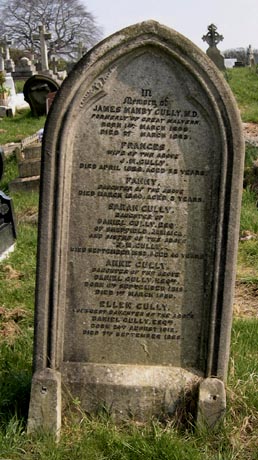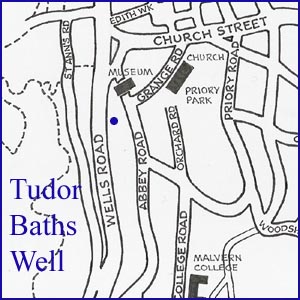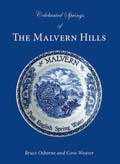
| 
|


Tudor Baths and Well
NGR 77530 45700
Site Number: C112
By Bruce Osborne and Cora Weaver (C) 2012
Area 1. Malvern Town Centre Springs and Wells
Malvern Hills, England
Description: on private property, beneath a rubbish tip at the north end of Holyrood House, adjacent to Hay Well Walk.
Although described as a well, the Tudor Well is in fact a contained spring. Situated about fifty yards from the Hay Well it formerly lay beneath a building known as both the Tudor Well Baths and Tudor Well Cottage, immediately adjacent to Haywell Walk. These baths are now gone and the site is a rubbish tip.
The supply was discovered in the early 1850s when workmen, excavating for the installation of a gas plant, accidentally struck a substantial spring of water. The yield was of such quality that the proprietors of Tudor House decided to convert the excavations to tanks and contain the supply for use. A substantial underground tank was constructed alongside Holyrood House. The estimated yield was about 20,000 gallons per day. This evidence was used in an extended lawsuit in 1908 relating to the 1905 typhoid outbreak at Dr Fergusson's Hydropathic Establishment (see The Establishment Fountain).
From the 1840s to the 1870s Tudor House, Holyrood House and the Tudor Well Baths were owned by Dr James Manby Gully, one of the country's foremost hydropathic doctors. Almost every summer during that period there was such a shortage of water in the public main that, when water was available, it was supposed only to be used for domestic purposes and not the water cure. The well was to greatly aid Dr Gully therefore as a water source for the Tudor Baths.
The Tudor Well Baths - Some time after the containment of the water source the Tudor Well Baths were erected over the site in the old cherry orchard. This was an elaborate building with castellations and a turret, which lay adjacent to Hay Well Walk. The baths covered just over 1000 sq ft and were used for hydropathy in conjunction with the adjacent Hay Well Baths. The building which housed the baths was still standing in the 1920s.
Dr Gully left Malvern in 1872 and by the 1880s hydropathy had almost died out in Malvern.
When the Tudor Hotel was sold in 1926, the sale catalogue records a "Brick and Slate Building, formerly the old Wellhouse, now used as stores". It was demolished by the 1960s. All that remains above ground now is some ruinous brickwork and until recently an ancient doorway through the wall into Haywell Walk. Below ground are a number of cisterns, one for the supply to Salisbury House - formerly Fonthill - and one for the containment of the Tudor Well spring. The site is covered in a substantial amount of rubbish built up over many years and would merit excavating. The well was exposed in the late 1990s but is now concealed again. Severn Trent Water has inherited this small part of the total property.
The Tudor Water monopoly - Tudor House and the linked Holyrood House were formerly the property of Dr Gully, famed as one of the most imminentt hydropathic doctors in Malvern in the mid-nineteenth century. It is interesting to note that Dr Gully was the first Chairman of the Local Board, which was grappling with dire water shortages as the town expanded. Having his own supplies it was in Dr Gully's commercial interest to prevent competitive doctors having prolific supplies for hydrotherapy. This may partly explain the Board's reluctance to take decisive action to secure a reliable and adequate town supply. In the mid-nineteenth century the Chairman of the Board was both revered and untouchable.
The water from the public main was always in such short supply that it was only to be used for domestic purposes. It was not to be used for baths, hydropathy, fountains, gardens, ornamental or horticultural purposes, or manufacturing. In 1864, when 14 medical men in the town signed a memorial stressing the need for a suitable public water supply, Dr Gully, then Chairman of the Board of Commissioners, refused to sign, 'as it was not couched in precisely the terms with which he agreed. But seeing this was a question which could not now be remedied, he was much afraid a definite answer could not be given to it at present'.
 When Dr Gully left Malvern in 1872 Tudor House was a successful and busy boarding house. After Dr Gully's death in 1883 the property passed to his son, William Court Gully. Tudor House was leased from 1876 on the `lease for life' policy to Elijah Finn, who ran it as a boarding house. Finn was eminently successful; he had sixty to eighty people on his visitor list all year round! He died in July 1886 and in the following August the property was bought by the Misses Brown. That year, 1887, was the year of Malvern's worst drought; the reservoirs were empty, the springs dry, and water as precious as gold. The Local Board located all prolific private sources and, with the owners' permission, pumped water into the mains. In October they installed pipes, a pump and a gas engine to the Tudor Baths Spring and pumped 10,000 - 15,000 gallons daily. The manager, Mr Buckingham, believed that the quantity could be doubled if all the water sources on the premises were tested.
When Dr Gully left Malvern in 1872 Tudor House was a successful and busy boarding house. After Dr Gully's death in 1883 the property passed to his son, William Court Gully. Tudor House was leased from 1876 on the `lease for life' policy to Elijah Finn, who ran it as a boarding house. Finn was eminently successful; he had sixty to eighty people on his visitor list all year round! He died in July 1886 and in the following August the property was bought by the Misses Brown. That year, 1887, was the year of Malvern's worst drought; the reservoirs were empty, the springs dry, and water as precious as gold. The Local Board located all prolific private sources and, with the owners' permission, pumped water into the mains. In October they installed pipes, a pump and a gas engine to the Tudor Baths Spring and pumped 10,000 - 15,000 gallons daily. The manager, Mr Buckingham, believed that the quantity could be doubled if all the water sources on the premises were tested. Unfortunately the pumping interfered with the water from the Mason Tank which supplied Chatsworth House, Tintern House and Fonthill, and the tenants and owners, represented by Mr Warwick, served a notice of action for damages on the Local Board. A report followed an independent examination of the workings: "The result of this inspection proves that the plaintiffs depend entirely for their water on Mason's tank, and that when the pump is at work on the Tudor House property it lowers Mason's tank, and thus stops the supply to the plaintiffs premises".[1] The Local Board ceased pumping and the plaintiffs withdrew their action. Two months later the Board bought the gas pump from Messrs Piercy & Co. for 164 pounds 5 shillings.[2]
In their letter to the Local Board the plaintiffs had written, '... we are not desirous of carrying on a contest merely for the purpose of finding out what is the actual connection between the Tudor House property and Mason's tank...' The houses in Abbey Road were built in the 1840s and had relied on the Mason tank ever since; the Tudor Well was not discovered until the 1850s. Who might have wanted, or felt they needed, to connect the two?
The Tudor sources were so notoriously prolific that during the water supply debate of 1887 the Civil Engineers engaged on the project suggested that the well be deepened to provide more water for the public main. Mr James Mansergh C.E, reported: "I examined the wells at Tudor House...and have seen the analysis of the water they yield. It is a little harder than the hill water, but I think it is desirable that he Board should try and acquire this source".[3] In 1890 Mr Mansergh suggested that the Local Board should purchase the well as part of their quest to find an infallible, pure, soft water supply.[4] By 1897, however, the 44 million gallon British Camp Reservoir was in use and the Tudor House well was no longer required. As a mark of the proprietors' public spirit the Urban District Council decided to allow them up to 100,000 free gallons of water from the public mains.[5]
This was not the end of the public utilisation of the Tudor Baths source however. The Malvern Gazette 2 May 1924 reported that the Council had acquired 20,000 gpd from a natural spring to supply the proposed new public baths in Grange Road - so the supply didn't have to come from the public main - it was coming from the Tudor Well. This had first been discussed in 1923 but the Council couldn't decide on anything except where the water was coming from. The Council had previously held a lease that had expired in 1905 but by 1919 the Council considered buying the site for not more than 300 pounds. This was increased in 1920 to 400 pounds.[6] It was a useful purchase because three years later the council considered building open-air swimming baths in Malvern. The hand-dug baths eventually opened in Priory Park on 4th July 1927 and were filled with water from the Tudor Well.
The site of the Tudor Baths and well was eventually inherited by Severn Trent Water. Today the site is covered in soil, old bricks and other debris that has amassed over many decades and is probably worth excavating. Gabions have been put on the bank adjacent to the well in 2012 and it is hoped that this is the first stage in landscaping this water feature.
Illustrations:
1. The castellated Tudor Well Baths. (courtesy Brian Iles)
2 & 3. The Well in May 2000.
4. Dr Gully's hair restorer - not one of his best creations judging from the next picture.
Footnotes:
[1] Malvern Advertiser 14 Jan 1888.
[2] Malvern Advertiser 10 Mar 1888.
[3] Malvern Advertiser 9 Mar 1889.
[4] Malvern Advertiser 22 Nov 1890.
[5] Malvern Advertiser 31 July 1897.
[6] Minutes of Malvern Urban District Council 4 November 1919, 3 February 1920.

Website: Click Here
SUPPLEMENTARY INFORMATION

Celebrated Springs of
THE MALVERN HILLS
 A definitive work that is the culmination of 20 years researching the springs and wells of the Malvern Hills, published by Phillimore. This is the ideal explorers guide enabling the reader to discover the location and often the astounding and long forgotten history of over 130 celebrated springs and wells sites around the Malvern Hills. The book is hard back with dust cover, large quarto size with lavish illustrations and extended text. Celebrated Springs contains about 200 illustrations and well researched text over a similar number of pages, together with seven area maps to guide the explorer to the locations around the Malvern Hills. It also includes details on the long history of bottling water in the Malvern Hills.
A definitive work that is the culmination of 20 years researching the springs and wells of the Malvern Hills, published by Phillimore. This is the ideal explorers guide enabling the reader to discover the location and often the astounding and long forgotten history of over 130 celebrated springs and wells sites around the Malvern Hills. The book is hard back with dust cover, large quarto size with lavish illustrations and extended text. Celebrated Springs contains about 200 illustrations and well researched text over a similar number of pages, together with seven area maps to guide the explorer to the locations around the Malvern Hills. It also includes details on the long history of bottling water in the Malvern Hills.
Written by Bruce Osborne and Cora Weaver, this book is available on-line for £15.00 (delivered UK) - click Malvern Bookshop on the green panel top left. Alternatively send a cheque payable to Cora Weaver with your name and address to 4 Hall Green, Malvern, Worcs. WR14 3QX.
1) TOPOGRAPHICAL LOCATION:
Malvern Hills - arguably Britain's original National Park
2) LANDSCAPE:
Built Up Location3) INFORMATION CATEGORY:
A Spring, Spout, Fountain or Holy Well Site4) MALVERN SPRING OR WELL SITE DETAILS:
2 SPLASHES - Not Much To See
5) GENERAL VISITOR INFORMATION:
Access On FootOn Private Property
Not Open To Public


